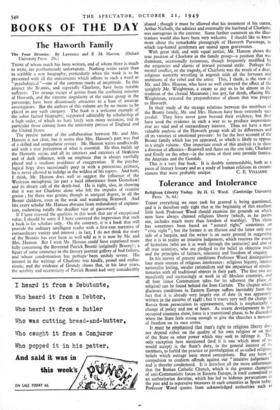BOOKS OF THE DAY
The Haworth Family
The Four Brontës. By Lawrence and E M. Hanson. (Oxford University Prcss. 25s.) THOSE of whom much has been written, and of whom there is much to write, are posthumously unfortunate. Nothing seems easier than to scribble a new biography, particularly when the work is to be presented with all the enticements which adhere to such a word as "psychological "—one of the common masks of ineptitude. In this respect the Brantes, and especially Charlotte, have been notable sufferers. The strange escape of genius from the confining miseries of Haworth, and the extreme singularity of the entire group in the parsonage, have been disastrously attractive to a host of amateur investigators. But the authors of this volume are by no means to be placed in any such category. The book is a welcome example of the sober factual biography, supported admirably by scholarship of a high order, of which we have lately seen many instances, and in particular those coming from the university presses of England and the United States.
The precise nature of the collaboration between Mr. and Mrs. Hanson is not clear, but it seems that Mrs. Hanson's part was that of a skilled and sympathetic reviser. Mr. Hanson writes unaffectedly and with a true perception of what is essential. He thus builds up the Haworth scene, and all its interiors and exteriors of bleakness and of dark influence, with an emphasis that is always carefully placed and a studious avoidance of exaggeration. If the psycho- logical bogy does occasionally peep in with a portentous grimace, he is never allowed to indulge in the wildest of his capers. And here, I think, Mr. Hanson does well to suggest the influence of the Wesleyan metaphysic (in part a local inheritance from Grimshaw) and its dreary cult of the death-bed. He is right, also, in showing that it was not Charlotte alone who felt the impulse of creative genius ; for there was genius, though in unequal degree, in all the Brontë children, even in the weak and wandering Branwell. And like every scholar Mr. Hanson abstains from redundancy of explana- tion, eschewing totally the deadlier vice of guesswork.
If I have stressed the qualities in this work that are of exceptional value, I should be sorry if I have conveyed the impression that such a book is for scholars only. On the contrary, it is a book that will provide the ordinary intelligent reader with a first-rate narrative of extraordinary variety and interest ; in fact, I do not think the story of the Brontës has ever been so well told as it is now by Mr. and Mrs. Hanson. But I wish Mr. Hanson could have expatiated more fully concerning the Reverend Patrick Bronte (originally Brunty) ; a figure of some eminence in the literary portrait gallery of bad fathers, and whose condemnation has perhaps- been unduly severe. His interest in the writings of Charlotte was kindly, proud and enthu- siastic, and the evidence of Grundy shows that, in his later years, the acerbity and eccentricity of Patrick Brontë had very considerably abated ; though it must be allowed that his treatment of his curate, Arthur Nicholls, the admirer and eventually the husband of Charlotte, was outrageous in the extreme. Some further comment on the illus- trations would also have been very welcome. I should like to know more about the remarkable photograph of Haworth Parsonage, in which top-hatted gentlemen are seated upon gravestones.
With great skill, and with equal justice, Mr. Hanson shows the true position of Charlotte in the family group—a position that was dominant, occasionally tyrannous, though frequently modified by the exigencies and alarms of inward personal strife. Perhaps the mental conflict, or the tragedy, of Charlotte was the result of a dour, religious austerity wrestling in anguish with all the fervours and ambitions of the rebel and the artist. This, I think, is the view of Mr. and Mrs. Hanson, who have so well conveyed the effect of the sprightly Mr. Weightman, a curate so gay as to be almost in the tradition of the clerical Macaronis ; too gay, for death, effacing Mr. Weightman' restored the preponderance of gloom that was proper to Haworth.
In their study of the strange relations between the members of the Brontë family, Mr. and Mrs. Hanson have been extremely suc- cessful. They have never gone beyond their evidence, but they have used the evidence in such a way as to produce impressions that are vital and of extraordinary interest. Thus we have a most valuable analysis of the Haworth group with all its differences and all its varieties of emotional pressure: by far the best account of the Brontë family which has yet appeared, or which is likely to appear, in a single volume. One important result of this analysis is to show a division of affinities—Branwell and Anne on the one side, Charlotte and Emily on the other—in the terms of their own juvenile fantasy, the Angrians and the Gondals.
This is a very fine book. It is doubly commendable, both as a piece of literary history and as a study of human relations in circum- stances that were probably unique. C. E. VULLIAMY.


































 Previous page
Previous page